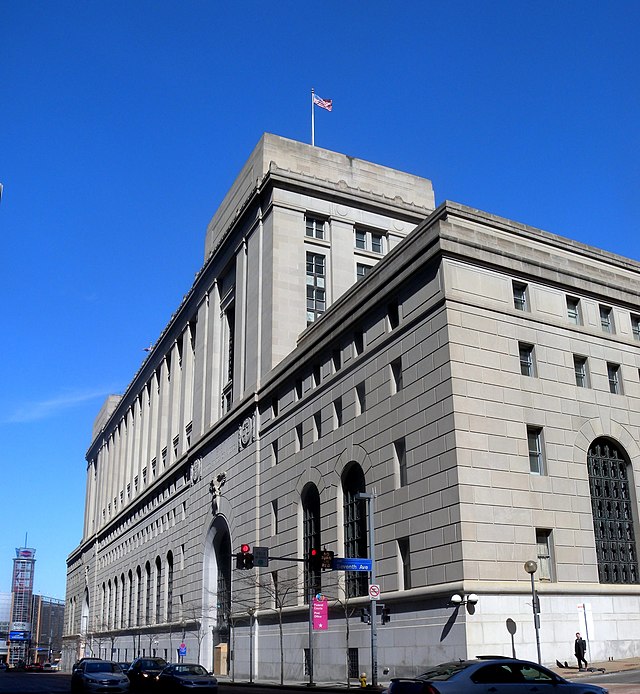Top Qs
Timeline
Chat
Perspective
United States District Court for the Western District of Pennsylvania
United States federal district court in Pennsylvania From Wikipedia, the free encyclopedia
Remove ads
The United States District Court for the Western District of Pennsylvania (in case citations, W.D. Pa.) is a federal trial court that sits in Pittsburgh, Erie, and Johnstown, Pennsylvania. It is composed of ten judges as authorized by federal law. Appeals from this court are heard by the United States Court of Appeals for the Third Circuit (except for patent claims and claims against the U.S. government under the Tucker Act, which are appealed to the Federal Circuit).
Remove ads


Remove ads
History
The United States District Court for the District of Pennsylvania was one of the original 13 courts established by the Judiciary Act of 1789, 1 Stat. 73, on September 24, 1789.[1][2] It was subdivided on April 20, 1818, by 3 Stat. 462,[1][2] into the Eastern and Western Districts to be headquartered in Philadelphia and Pittsburgh, respectively.[1] The court began its first session on December 7, 1818 at the Old County Courthouse in Pittsburgh.[3] Portions of these districts were subsequently subdivided into the Middle District on March 2, 1901, by 31 Stat. 880.[2] At the time of its initial subdivision, presiding judge Richard Peters Jr. was reassigned to only the Eastern District. This made it possible for President James Monroe to appoint Jonathan Hoge Walker as the first judge of the Western District of Pennsylvania.
The Erie courthouse and division was split from Pittsburgh for initial actions in January 1867, with the Johnstown courthouse and division being split from Pittsburgh for initial actions in 1989.[3]
Remove ads
Current judges
Summarize
Perspective
As of October 6, 2024[update]:
Remove ads
Former judges
- Recess appointment; formally nominated on December 7, 1831, confirmed by the United States Senate on March 21, 1832, and received commission the same day.
- Recess appointment; formally nominated on December 3, 1906, confirmed by the Senate on December 11, 1906, and received commission the same day.
- Recess appointment; formally nominated on December 6, 1928, confirmed by the Senate on December 17, 1928, and received commission the same day.
- Recess appointment; formally nominated on January 5, 1950, confirmed by the Senate on March 8, 1950, and received commission on March 9, 1950.
- Recess appointment; formally nominated on January 15, 1962, confirmed by the Senate on July 10, 1962, and received commission on July 12, 1962.
Remove ads
Chief judges
Chief judges have administrative responsibilities with respect to their district court. Unlike the Supreme Court, where one justice is specifically nominated to be chief, the office of chief judge rotates among the district court judges. To be chief, a judge must have been in active service on the court for at least one year, be under the age of 65, and have not previously served as chief judge.
A vacancy is filled by the judge highest in seniority among the group of qualified judges. The chief judge serves for a term of seven years, or until age 70, whichever occurs first. The age restrictions are waived if no members of the court would otherwise be qualified for the position.
When the office was created in 1948, the chief judge was the longest-serving judge who had not elected to retire, on what has since 1958 been known as senior status, or declined to serve as chief judge. After August 6, 1959, judges could not become or remain chief after turning 70 years old. The current rules have been in operation since October 1, 1982.
Remove ads
Succession of seats
Summarize
Perspective
Remove ads
United States attorneys
Summarize
Perspective
United States attorneys for the district have included:[4]
- James Hamilton March 11, 1801
- Andrew Stewart April 20, 1818
- Alexander Brackenridge March 3, 1821
- George W. Buchanan October 22, 1830
- Benjamin Patton Jr. October 22, 1832
- John P. Anderson June 12, 1839
- Cornelius Darragh March 25, 1841
- William O'Hara Robinson March 29, 1844
- John L. Dawson July 22, 1845
- J. Bowman Sweitzer August 27, 1850
- Charles Shaler April 19, 1853
- Richard Biddle Roberts April 21, 1857
- Robert B. Carnahan April 12, 1861
- Henry B. Swope January 24, 1870
- David Reed March 24, 1874
- Henry H. McCormick June 29, 1876
- William A. Stone July 6, 1880
- George A. Allen December 4, 1886
- Walter Lyon June 21, 1889
- Stephen C. McCandless April 26, 1893
- Harry Alvan Hall June 8, 1893
- B. Heiner September 14, 1897
- James S. Young February 10, 1902
- John W. Dunkle March 17, 1905
- John H. Jordan April 15, 1909
- Edwin Lowry Humes September 10, 1913
- R. Lindsay Crawford September 2, 1918
- Edwin Lowry Humes August 20, 1919
- Robert J. Dodds June 1, 1920
- D. J. Driscoll August 19, 1920
- Walter Lyon March 11, 1921
- John D. Meyer July 18, 1925
- Louis Edward Graham October 31, 1929
- Horatio S. Dumbauld August 17, 1933
- Charles F. Uhl May 12, 1941
- Owen McIntosh Burns May 16, 1947
- Edward C. Boyle November 3, 1949
- John W. McIlvaine July 16, 1953
- D. Malcolm Anderson Jr. August 19, 1955
- Hubert I. Teitelbaum March 17, 1958
- Joseph S. Ammerman June 5, 1961
- Gustave Diamond February 2, 1963
- Richard L. Thornburgh June 4, 1969
- Blair A. Griffith July 7, 1975
- Robert J. Cindrich September 29, 1978
- J. Alan Johnson July 31, 1981
- Charles D. Sheehy January 15, 1989
- Thomas W. Corbett November 30, 1989
- Frederick W. Thieman August 16, 1993[5]
- Linda L. Kelly August 1, 1997
- Harry Litman October 22, 1998
- Linda L. Kelly April 28, 2001
- Mary Beth Buchanan – September 18, 2001
- Robert S. Cessar – November 17, 2009
- David J. Hickton – August 12, 2010
- Soo C. Song (acting) – November 29, 2016
- Scott Brady – December 22, 2017
- Cindy Chung – November 2021[6]
- Troy Rivetti (acting) – February 17, 2023[7]
- Eric G. Olshan – June 12, 2023
Remove ads
See also
References
External links
Wikiwand - on
Seamless Wikipedia browsing. On steroids.
Remove ads


